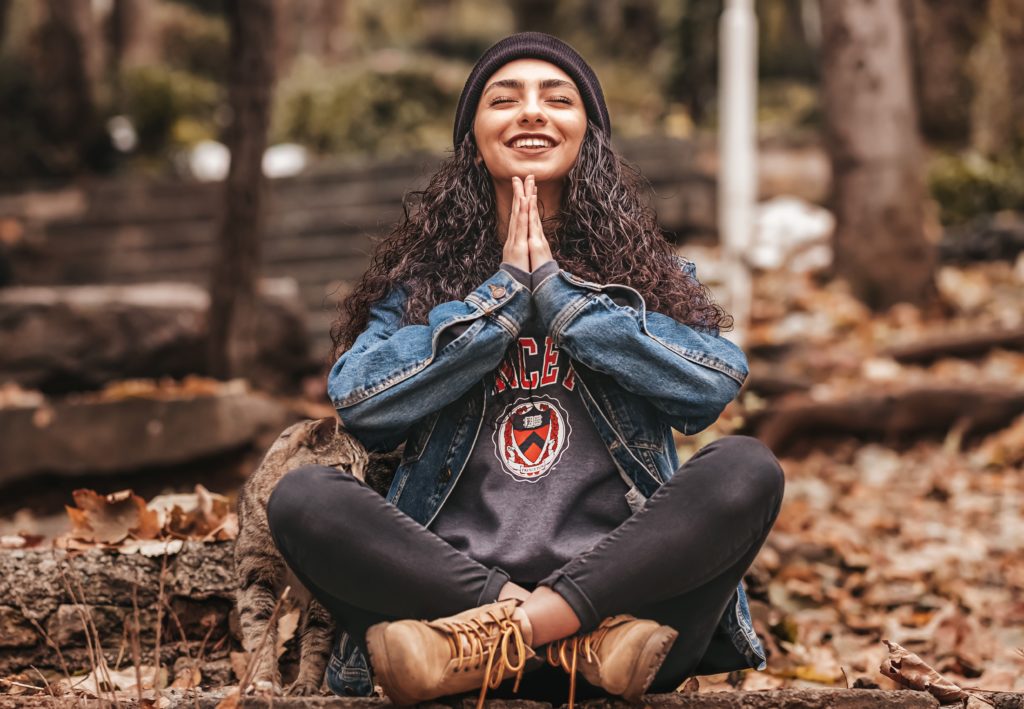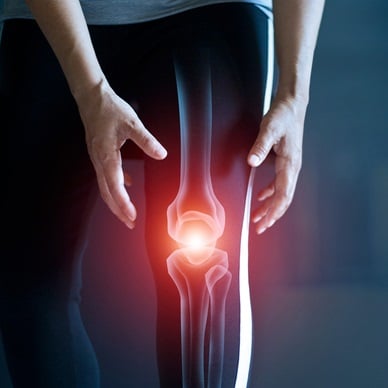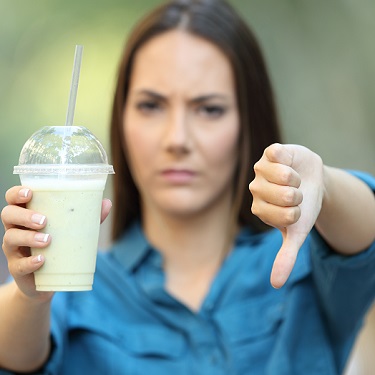Is Meditation as Powerful as Medicine for Anxiety?

Anxiety is a growing concern for many of us. Just ask around, and you’ll find people are feeling more and more anxious. According to research, 19% of men and 31% of women in the U.S. will experience an anxiety disorder at some point in their lives. 1 An estimated 6.8 million U.S. adults experience generalized anxiety disorder, with less than half receiving treatment. Fortunately, there are also growing solutions, including medication, therapy, self-care, and meditation to help address the problem.
Recently, scientists put mindfulness meditation directly up against a common medication prescribed for anxiety disorder and found they were equally effective. There were, however, pros and cons to both methods. First, though…
What is Anxiety Disorder?
Anxiety occurs when the mind and body react to stressful, dangerous, or unfamiliar situations. For instance, it’s the feeling of dread before a significant event, confrontation, or big change. Normal anxiety can result in:
- Panicky breathing
- Pounding heart
- Trouble sleeping
- And even worry loops.
Anxiety is a natural reaction to significant stress. It causes us to stay alert, aware, and ready to take on whatever is facing us. It provides a protective bodily response by boosting heart and breathing rate to pump oxygenated blood into the muscles, so we’re prepared to fight or flee. Having the right dose of healthy anxiety can help you stay focused to meet your deadline, study harder for an exam, or run away from danger.
Unfortunately, for people with anxiety disorder, anxiety can be a highly distressing, impairing condition and can even become debilitating. The responses to normal stresses become dysregulated, causing people to overreact to minor stresses or react when the situation doesn’t necessarily call for it.
Symptoms can increase until it’s difficult to cope with normal, common worries or the type of anxious moments that are just part of life. Just a few of the most common anxiety disorders include:
• Generalized anxiety disorder, which is revealed by excessive worry on issues for days, weeks, or months. It often involves physical symptoms like tight muscles, increased heart rate, and dizziness.
• Social anxiety disorder, when you feel great anxiety before and during social situations or when speaking in front of others.
• Phobias, such as a fear and anxiety when faced with a specific animal, insect, or situation.
• Panic disorder, which leads to intense incidents of heavy breathing, dread, and a pounding heart. It’s the feeling of being chased by a wild animal, only without any animal.
If this anxiety persists, becomes excessive, or is routinely caused by non-threatening situations, it’s time to reach out to a mental health professional to discuss options. Anxiety isn’t just uncomfortable. Persistent anxiety can increase levels of cortisol and raise blood pressure, which can lead to heart issues, kidney disease, and sexual dysfunction over time. It’s also no picnic to live with. The intrusive thoughts, dread, self-consciousness, and fear can interfere with work, school, activities, and relationships as people may begin to isolate and avoid many of the things that bring joy into our lives.
Treatment Options for Anxiety Disorders
For those suffering, fortunately, there are several effective options that can help bring you back into balance. Some common recommendations include:
- Lifestyle adjustments, such as regular exercise and avoiding substances (such as coffee) that may lead to or increase anxiety.
- Psychotherapy, including cognitive behavioral therapy or exposure therapy to help you challenge and reframe unhelpful thinking and actions with support from a therapist.
- Medications, which can be taken only when anxiety levels spike or more regularly under the careful watch of a doctor.
- And now, mindfulness practices, including deep breathing and mediation.
The best solution for many is a combination of approaches to help disarm anxiety until it becomes more manageable.
Medication vs. Mindfulness: What’s Better?
Found in the November 9, 2022 issue of JAMA Psychiatry, a recent study took a look at adults who had anxiety disorders. The adults were randomly split into two groups. Over the next eight weeks, one group of participants followed a mindfulness-based stress reduction program (MBSR) starting with a one-day weekend class followed by 2.5-hour per week group classes, and 45-minute per day home practice sessions. The other group was given a pill. Specifically, they received a common medication used for anxiety (i.e., 10 to 20 mg of escitalopram [brand name, Lexapro]). Assessments were evaluated after 8 weeks with 12- and 24-week follow ups. 2
This study revealed that both options were equally effective. After just eight weeks of treatment of either medication or mindfulness, individuals experienced around a 20 to 30% decrease in troubling symptoms. The study author, Dr. Elizabeth Hoge, reported, “For both treatments, we had people who said, ‘This really worked.’”
There were pros and cons for each group. For instance, the mindfulness group was given the opportunity to learn several techniques, including body scanning, mindful movement, and breath awareness, which can be used to reduce stress and improve overall mental health. This, however, involved a huge time commitment, which can be challenging in today’s busy world. After all, many of us are juggling jobs (sometimes more than one), care for kids or aging parents, relationships, commutes, and other priorities.
The medication group only needed to take a pill. However, they only studied a single medication—escitalopram. This medication is evidence-based to treat anxiety disorder, but it may not be the right medication for you. And all medications come with some side effects. For instance, common side effects of escitalopram include:
- Sexual dysfunction or decreased interest
- Heartburn, nausea, and diarrhea
- Dry mouth
- Drowsiness and fatigue
- Headache
- Insomnia
- Dizziness
- Increased levels of anxiety
In the study, nearly 80% of the medication participants experienced at least one side effect. Fortunately, most side effects are reported to be fairly mild and short-term, lasting no more than two weeks. Larger doses are more likely to lead to side effects. 3
The study did involve a great deal of time-commitment for the mindfulness participants. This may explain why just 28% of the meditation group was practicing at least 4 days a week when the researchers checked in 6 months later. That’s compared to 58% who continued using the drug. It’s unclear why people stopped treatment. Was it because they were no longer experiencing symptoms or was it too inconvenient?
That said, while it takes time to learn proper mindfulness techniques, the practices don’t necessarily have to take hours every week. They can, according to mindfulness experts, easily fit into each day. In fact, you may enjoy benefits with just five or ten minutes when engaged in mindful activities, such as:
- Breathing: take a deep breath, hold it for a count of three, and then slowly release it. Repeat six times.
- Drinking: start the day with a hot cup of water with lemon or a favorite, soothing tea. Sip slowly with no distractions as you prepare for the day. An afternoon cup may be beneficial as well.
- Sensing: notice the sounds around you—the birds chirping, the cars going by, or the dogs barking in the distance. You can also choose to focus on what your fingers are feeling or what your eyes are seeing.
- Eating: your mouth offers another sense. Focus on your foods—how they taste, their texture or temperature, and how it feels to chew each bite. Slow down and avoid distractions as you do so.
- Walking: allow your feet to connect with the earth fully. Feel each step, listen to the sound you make as you walk, and connect with the ground beneath you.
- Scanning: take a moment to scan your body. Do you feel any tightness or discomfort? Breathe into each part of your body and allow it to fully relax.
- Focusing: no matter what you’re doing, just do that one thing—whether that’s eating, communicating with a friend, family member, or co-worker, going through emails, doing dishes, journaling, drawing, and etc.
There’s no perfect way to practice. It’s about finding the approach that fits your needs and lifestyle. But many have found ways to more easily fit a mindfulness practice into their daily lives, often by starting with just one minute a day.
Learning to allow thoughts to just be and move on from them gives you greater freedom. Over time, the thoughts, what ifs, past regrets, and future concerns lose power to control you. This means you can more positively respond to stress or intrusive thoughts instead of reacting to them. It does, however, take time to learn.
Other benefits of meditation and mindfulness can include:
- Gaining new perspectives
- Building skills to manage stressful situations
- Increasing self-awareness
- Focusing on the present moment
- Decreasing negative thoughts and emotions
- Increasing imagination
- Boosting creativity
- Promoting patience
- Lowering heart rate
- Decreasing blood pressure
- Improving sleep 4
Mindfulness: There’s an App for It
While it is highly recommended and helpful to work with a therapist, especially if you have severe symptoms, you can also learn to meditate without an eight-week program. In fact, there are many apps available that offer guided mediations and other teaching tools. Some popular options include:
- Buddhify
- Calm
- Headspace
- Insight Timer
- 10% Happier by Dan Harris
- Waking Up
- Aura
- Meditation Studio
Others find that a yoga or stretching program with breathing exercises can help them release stress and anxiety, so it doesn’t build up and they are better able to cope.
Choosing the Right Solution for You
All of us are unique, and what works best for you may not be the best approach for another person. While mindfulness can be a powerfully effective approach, some people in the mindfulness group found it made them feel more anxious. (There were also some in the drug treatment group who experienced increased anxiety.) So, you may need to experiment to find which solution is most effective for you and your circumstances. And again, the best solutions are often a combination of treatments. Other evidence-backed options include:
- Acupuncture 5, 6
- Chamomile, lavender, or lemon balm as teas, supplements, or aromatherapy 7 – 13
- Nutrients like omega-3 fatty acids, vitamins B6 and B12, and magnesium, especially if you are deficient 14 – 21
- L-theanine (found in green tea) 22 – 23
- Moving the body with regular exercise such as walking, cycling, swimming, or yoga. Even short 5- to 10-minute workouts can help provide relief. 24
- Positive affect journaling, where you write down your positive thoughts and emotions. 25
Anxiety disorders can be challenging mental health issues. And quick fixes are unlikely, if not impossible. But you can find solutions that could help more and more over time. And if what you’re doing isn’t working—whether that’s working with a specific therapist, a medication, meditation, or other lifestyle changes—keep trying and work with trained mental health professionals who can help you create the right plan for you.





 US Doctor: "Eating This Every Day Can Snap You Into Ketosis"
US Doctor: "Eating This Every Day Can Snap You Into Ketosis" 3 Key Nutrients to Help Lubricate Your "Tin Man" Joints
3 Key Nutrients to Help Lubricate Your "Tin Man" Joints AVOID Plant-Based Protein Powders (unless...)
AVOID Plant-Based Protein Powders (unless...)

